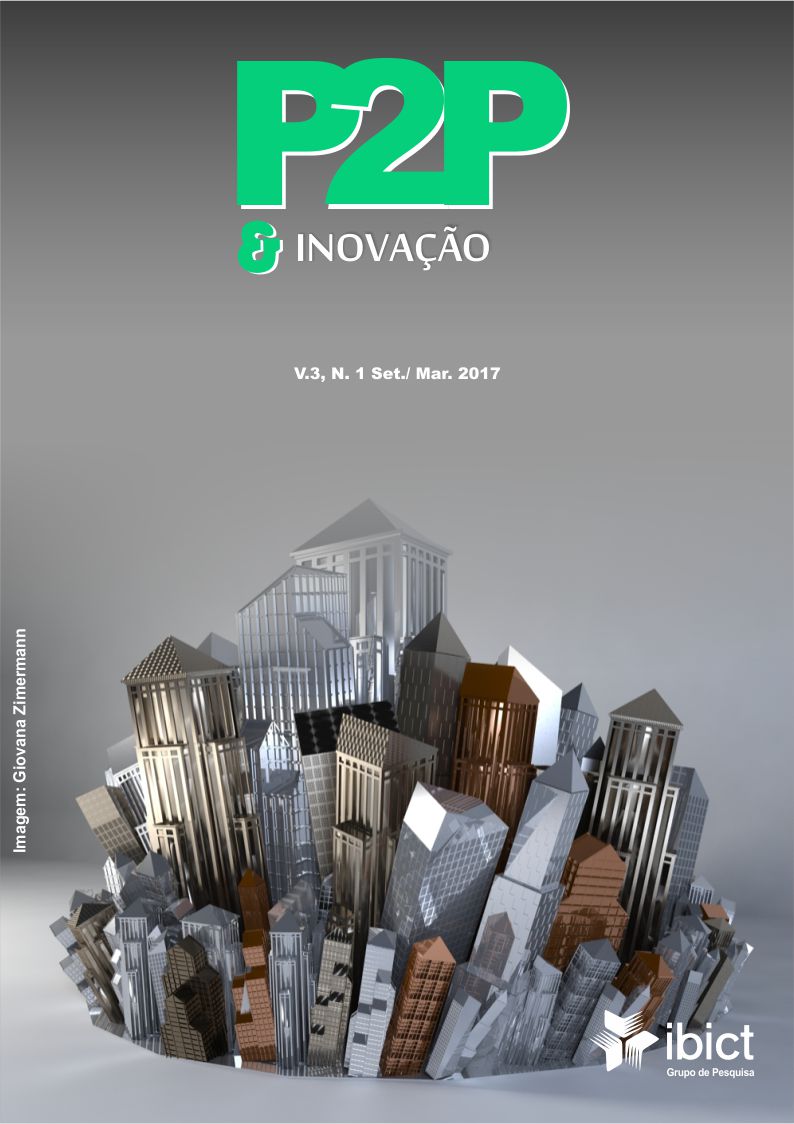THE PLACE OF THE COMMONS IS THE SQUARE
DOI:
https://doi.org/10.21721/p2p.2016v3n1.p15-36Abstract
Squares are a distinctive fixture of a city. They form the centre of gravity of urban live and have been of paramount importance for social interaction through all cultures and in all centuries. The square is the centre of attention of every urban agglomeration. It's the spot where people gather and where commonality takes place. Squares are important as a place where the social is geographically embodied, as the space of the commons. They are the spot for sense, the space where sense making take place and where the social is constituted. Democracy was born on the square and they still are the place of politics. They are literally a place. In order to be the place of sense making, squares have to be empty; they are an expanse without artefacts. It's the emptiness of the square that makes them so suitable for social meaning. A plain surrounded by a maze of street and alleys so that the difference between the environment and the place enhance the openness of the square. In order to support meaning the square has certain specific features. One of them is the light. Everyone is in the same light in a square and therefore can see each other. The emptiness of the square makes a horizontal gaze possible where everyone is equal. There are no vantage points to observe the crowd. Architectural elements underline the equality and safety of the place. A square needs to be a safe place where one feels at home and not be disoriented by the emptiness. This essentially equalitarian and meaningfulness of the square has made the place also a place for contestation. All kind of different powers have colonized the square; the church, the king, the merchants, the state, the corporations. They all have changed the design of the square and tried to impose themselves on the openness. As a place of meaning the square is also a place of contestation between the commons and the powers. It has a long tradition of riots and occupation. It is the place where the people rise against the powerful. Of course it has also a long history of repression. Specific design aids to make sure the square can’t be used as a meaningful and common place. Squares embody communality and meaning by allowing multiplicity and what Nancy calls being singular plural. They are the space of the multitude. Attempts to design, organize, plan the square close the multiplicity down to singularities with specific functions and deny the square of its meaningfulness. The square is then the geographical space for meaningful politics and for the commons.
Downloads
References
CASTELLS, M. The power of identity: the information age: economy, society and culture. Londres: Wiley-Blackwell, 2009. 2 v.
COOP, P.; BRUNCKHORST, D. Triumph of the commons: age-old participatory practices provide lessons for institutional reform in the rural sector. Australasian Journal of Environmental Management, [s.l.], v. 6, n. 2, p.69-77, jan. 1999.
CUTINI, V. Spatial analysis of urban squares. Tema: Journal of Land Use, Mobility and Environment, [s.l.], p.247-258, 2014. Tema. Journal of Land Use, Mobility and Environment. Disponível em: <http://dx.doi.org/10.6092/1970-9870/2476>. Acesso em: 5 set. 2016.
DALE, K.; BURRELL, G. The spaces of organisation & the organisation of space, Basingstoke: Palgrave, 2008.
DEAN, J. Claiming division, naming a wrong. Theory & Event, [s.l.], v. 14, n. 4, 2011.
DHALIWAL, Puneet. Public squares and resistance: the politics of space in the Indignados movement. Interface: a journal for and about social movements, [s.l.], v. 4, n. 1, p.251-273, maio 2012.
FOUCAULT, M. Discipline and punish: the birth of the prison. Londres: Penguin, 1991.
GEHL, J.; GAMZOE, L. New city spaces. Copenhagen: The Danish Architectural Press, 2006.
GIDDINGS, Bob; CHARLTON, James; HORNE, Margaret. Public squares in European city centres. Urban Design International, [s.l.], v. 16, n. 3, p.202-212, 10 ago. 2011.
HARDT, M; NEGRI, A. Multitude. Londres: Penguin, 2004.
HARVEY, D. Rebel cities: from the right to the city to the urban revolution. London;New York: Verso, 2012.
HEIDEGGER, M. Building, dwelling thinking, In. Poetry, language, thought. Nova Iorque: HarperCollins, 1971.
ISHKANIAN, A.; GLASIUS, M.; ALI, I. Reclaiming democracy in the square? Interpreting the Movements of 2011-2012, Report, London: the London School of Economics and Political Science, 2013.
KAIKA, M.; KARALIOTAS, L. The spatialization of democratic politics: Insights from Indignant Squares. European Urban and Regional Studies, [s.l.], p.1-15, 8 maio 2014.
KÄRRHOLM, M. Territorial complexity: a study of territoriality, materiality, and the use of three squares in Lund. Nordic Journal of Architectural Research, [s.l.], v. 18, n. 1, p.144-199, 2005.
KOHN, M. Brave new neighborhoods: the privatization of public space. New York: Routledge, 2004.
SOUZA, Marcelo Lopes de; LIPIETZ, Barbara. The ‘Arab Spring’ and the city. City, [s.l.], v. 15, n. 6, p.618-624, dez. 2011.
MAECKELBERGH, M. Social movements and global governance. In. PARKER, M. et al (ed.). Routledge Companion to Alternative Organization. London: Routledge, 2014. p. 345-358.
MAROM, N. Activising space: the spatial politics of the 2011 protest movement in Israel. Urban Studies, [s.l.], v. 50, n. 13, p.2826-2841, 27 fev. 2013. Disponível em: <http://dx.doi.org/10.1177/0042098013477699>. Acesso em: 8 set. 2016.
MELUCCI, A. Challenging codes: collective action in the information age. Cambridge: Cambridge University Press, 1996.
MINTON, A. What kind of world are we building? The privatization of public space. London: RICS, 2006.
MOUGHTIN, C. Urban design: street and square. 3. ed. Oxford;Burlington: Architectural Press, 2003.
NANCY, J. L. La communauté affronté. Paris: Galillée, 2001.
NANCY, J. L. The innoperative community. Minneapolis: University of Minnesota Press, 1991.
NANCY, J. L. Being singular plural. Stanford: Stanford University Press, 2000.
NANCY, J. L. Communism, the word. In: DOUZINAS, C.; ZIZEK, S. (Ed.). The idea of communism. Londres; Nova York: Verso, 2010.
NANCY, J. L. The creation of the world or globalization. Albany: State University of New York Press, 2007.
NANCY, J. L.; BAILLY, J. C. La comparution. França: Christian Bourgois Éditeur, 1991.
ORS, I. R.. Genie in the bottle: Gezi Park, Taksim Square, and the realignment of democracy and space in Turkey.Philosophy & Social Criticism, [s.l.], v. 40, n. 4-5, p.489-498, 6 mar. 2014. Disponível em: <http://dx.doi.org/10.1177/0191453714525390>. Acesso em: 7 set. 2016.
Ostaijen van, P. Music hall. Amsterdam: Bert Bakker, 1982.
PATEL, D. Roundabouts and revolutions: public squares, coordination and the diffusion of the arab uprisings. Department of Government: Cornell University, 2013. Rascunho.
SANDE, Mathijs van de. The prefigurative politics of Tahrir Square: an alternative perspective on the 2011 revolutions. Res Publica, [s.l.], v. 19, n. 3, p.223-239, 14 mar. 2013.
SEWELL, W. H. Space in contentious politics. In: AMINZADA, R.; GOLDSTONE, J. E. A. (Ed.). Silence and voice in the study of contentious politics. Cambridge: Cambridge University Press, 2001.
SHEPARD, B. Occupy Wall Street, social movements, and contested public space. In: SCHIFFMAN, R., BELL, R. Beyond Zuccotti Park: freedom of assembly and the occupation of public space. p. 21-33, Oakland: New Village Press, 2012. p. 21-23.
SMITHSIMON, G. “A stiff clarifying test is in order” occupy and negotiating rights in public space. In: SCHIFFMAN, R.; BELL, R. (Ed.) Beyond Zuccotti Park: freedom of assembly and the occupation of public space. Oakland: New Village Press, 2012. p. 34-48.
STAVRIDES, S. Squares in movement. South Atlantic Quarterly, [s.l.], v. 111, n. 3, p.585-596, 1 jul., 2012.
SWYNGEDOUW, Erik. Where is the political? Insurgent mobilisations and the incipient “return of the political”. Space and Polity, [s.l.], v. 18, n. 2, p.122-136, 6 mar. 2014.
Downloads
Published
Issue
Section
License
The journal is published under the Creative Commons - Attribution - Noncommercial - Share Alike 3.0 Brazil.
The published work is considered collaboration and therefore the author will not receive any remuneration for this as well as anything will be charged in exchange for publication.
All texts are responsibility of the authors.
It’s allowed partial or total reproduction of the texts of the magazine since the source is cited.















